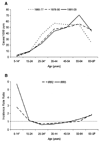Changing course of diabetic nephropathy in the Pima Indians
- PMID: 18842316
- PMCID: PMC2603306
- DOI: 10.1016/j.diabres.2008.09.014
Changing course of diabetic nephropathy in the Pima Indians
Abstract
Pima Indians from the Gila River Indian Community in Arizona have a high incidence rate of type 2 diabetes, and kidney disease attributable to diabetes is a major cause of morbidity and mortality in this population. Since 1965, each member of the population at least 5 years of age is invited to participate in a research examination every other year. During the past 43 years, the overall incidence of diabetes in the Pima Indians has not changed, but the incidence of diabetes among those less than 15 years of age has increased nearly 6-fold, as an increasing prevalence and degree of obesity in the youth have shifted the onset of diabetes to younger ages. The rising frequency of diabetes in the youth has led, in turn, to the emergence in mid-life of the major complications of diabetes, including kidney disease. On the other hand, the introduction and widespread use of medicines to control blood pressure, reduce hyperglycemia, and block the renin-angiotensin system (RAS) have lead to improvements in the average blood pressure and glycosylated hemoglobin levels in the diabetic population. These countervailing forces have influenced the course of diabetic nephropathy in a generally favorable direction in the past few years, as evidenced by the decline in the overall incidence of end-stage kidney disease since 1990. A continued increase in the incidence of type 2 diabetes in youth, however, threatens to reverse this trend.
Conflict of interest statement
None
Figures




Similar articles
-
Diabetic nephropathy in American Indians, with a special emphasis on the Pima Indians.Curr Diab Rep. 2008 Dec;8(6):486-93. doi: 10.1007/s11892-008-0083-1. Curr Diab Rep. 2008. PMID: 18990306 Free PMC article. Review.
-
Effect of youth-onset type 2 diabetes mellitus on incidence of end-stage renal disease and mortality in young and middle-aged Pima Indians.JAMA. 2006 Jul 26;296(4):421-6. doi: 10.1001/jama.296.4.421. JAMA. 2006. PMID: 16868300
-
Incidence of end-stage renal disease in type 2 (non-insulin-dependent) diabetes mellitus in Pima Indians.Diabetologia. 1988 Oct;31(10):730-6. doi: 10.1007/BF00274774. Diabetologia. 1988. PMID: 3240833
-
Diabetic kidney disease in Pima Indians.Diabetes Care. 1993 Jan;16(1):335-41. doi: 10.2337/diacare.16.1.335. Diabetes Care. 1993. PMID: 8422805 Review.
-
Determinants of end-stage renal disease in Pima Indians with type 2 (non-insulin-dependent) diabetes mellitus and proteinuria.Diabetologia. 1993 Oct;36(10):1087-93. doi: 10.1007/BF02374503. Diabetologia. 1993. PMID: 8243859
Cited by
-
Pima Indian Contributions to Our Understanding of Diabetic Kidney Disease.Diabetes. 2021 Aug;70(8):1603-1616. doi: 10.2337/dbi20-0043. Epub 2021 Jul 20. Diabetes. 2021. PMID: 34285119 Free PMC article. Review.
-
The determinants of complication trajectories in American Indians with type 2 diabetes.JCI Insight. 2021 May 24;6(10):e146849. doi: 10.1172/jci.insight.146849. JCI Insight. 2021. PMID: 34027894 Free PMC article.
-
Long-term effects of a randomised trial of a 6-year lifestyle intervention in impaired glucose tolerance on diabetes-related microvascular complications: the China Da Qing Diabetes Prevention Outcome Study.Diabetologia. 2011 Feb;54(2):300-7. doi: 10.1007/s00125-010-1948-9. Epub 2010 Nov 3. Diabetologia. 2011. PMID: 21046360 Clinical Trial.
-
HEROIC: a 5-year observational cohort study aimed at identifying novel factors that drive diabetic kidney disease: rationale and study protocol.BMJ Open. 2020 Sep 9;10(9):e033923. doi: 10.1136/bmjopen-2019-033923. BMJ Open. 2020. PMID: 32912939 Free PMC article.
-
Changing epidemiology of type 2 diabetes mellitus and associated chronic kidney disease.Nat Rev Nephrol. 2016 Feb;12(2):73-81. doi: 10.1038/nrneph.2015.173. Epub 2015 Nov 10. Nat Rev Nephrol. 2016. PMID: 26553517 Review.
References
-
- Knowler WC, Bennett PH, Hamman RF, Miller M. Diabetes incidence and prevalence in Pima Indians: a 19-fold greater incidence than in Rochester, Minnesota. Am J Epidemiol. 1978;108:497–505. - PubMed
-
- Ravussin E, Valencia ME, Esparza J, Bennett PH, Schulz LO. Effects of a traditional lifestyle on obesity in Pima Indians. Diabetes Care. 1994;17:1067–1074. - PubMed
-
- Schulz LO, Bennett PH, Ravussin E, Kidd JR, Kidd KK, Esparza J, Valencia ME. Effects of traditional and western environments on prevalence of type 2 diabetes in Pima Indians in Mexico and the U.S. Diabetes Care. 2006;29:1866–1971. - PubMed
-
- Joslin EP. The universality of diabetes. JAMA. 1940;115:2033–2038.
-
- Cohen BM. Diabetes mellitus among Indians of the American Southwest: its prevalence and clinical characteristics in a hospitalized population. Ann Intern Med. 1954;40:588–599. - PubMed
Publication types
MeSH terms
Grants and funding
LinkOut - more resources
Full Text Sources
Medical
Miscellaneous

